The Deep Dive
Korea faces apple crisis amid climate, demographic change
Korea’s apple production is expected to remain tight due to climate change, lack of apple growers and strict apple import rules
By Mar 14, 2024 (Gmt+09:00)
5
Min read
Most Read
LG Chem to sell water filter business to Glenwood PE for $692 million


KT&G eyes overseas M&A after rejecting activist fund's offer


Kyobo Life poised to buy Japan’s SBI Group-owned savings bank


StockX in merger talks with Naver’s online reseller Kream


Meritz backs half of ex-manager’s $210 mn hedge fund


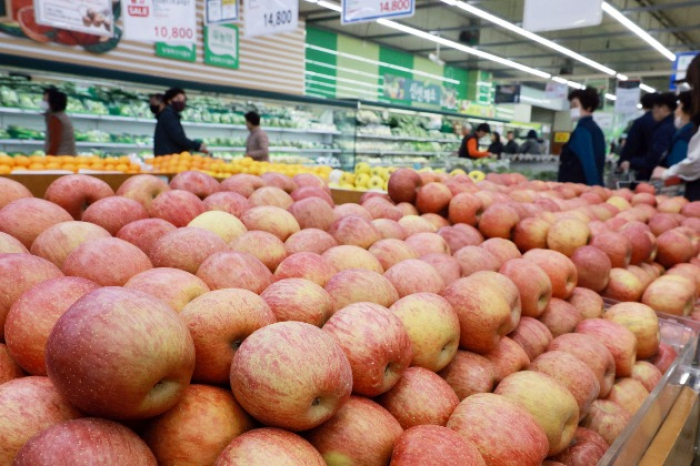
Apples, normally among the most common and available fruit, are poised to be a rarity in South Korea, where people are suffering a so-called “appflation” crisis due to an apple production shortage amid accelerating climate change, aging apple growers and the country’s strict apple import regulations.
The average wholesale price of apples hit 5,414 won ($4.11) per kilogram on Wednesday, up 1.96% from a week ago, according to the Korea Agricultural Product Price Index (KAPI) developed by Farmair and released by The Korea Economic Daily.
Compared to the prior year, the price climbed by 97.33%.
The hikes in apple prices led the country’s overall fresh fruit prices in February to jump 41.2% on-year, the biggest rise in 32 years and five months.
The main culprit for the runaway apple prices in Korea was climate warming-driven extreme weather conditions, which have hurt apple production.
The country’s apple production in 2023 declined 30% from the previous year to 394,000 tons.
But the outlook for Korea’s apple farming looks grim as the challenges the country is facing are nearly impossible to address in the short term.
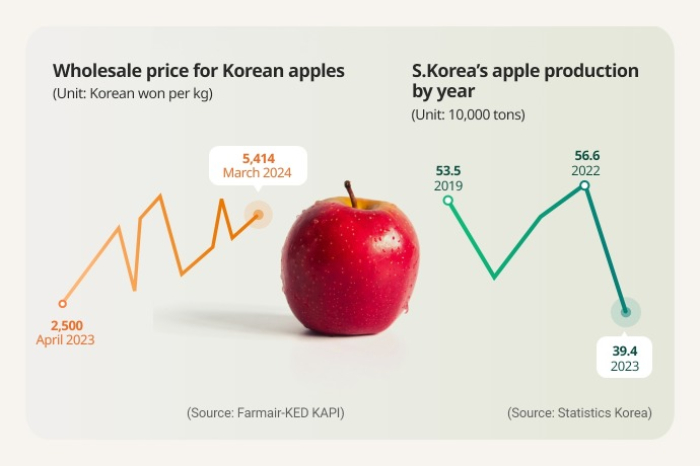
Climate change is set to reduce the country’s available apple-growing regions; the fast-aging population in the country’s rural areas has reduced the number of apple growers; and the country’s complicated and strict regulations on fresh fruit and vegetable imports have effectively blocked apple imports.
KOREAN PENINSULA GETTING HOTTER
Apple trees grow well in temperate zones with cold winters and hot, dry summers. Korean apples are normally harvested around October and then stored in cool storage for year-round consumption until the next harvest season.
Apples currently in the market in Korea were picked in 2023 but total apple production last year plunged to 394,000 tons from 566,000 tons in 2022 and 516,000 tons in 2021.
“Last year’s spring frost and cold spell hampered fruit setting and then frequent rains and torrential rains in the summer knocked down many apples. Just before the apple-picking season, the apple anthracnose outbreak hit apple orchards,” said Kwon In-ha, a distribution manager at the Daegu-Gyeongbuk Apple Farming Cooperative.
The worst is yet to come.
The city of Daegu and North Gyeongsang Province have been Korea’s top apple-growing regions.
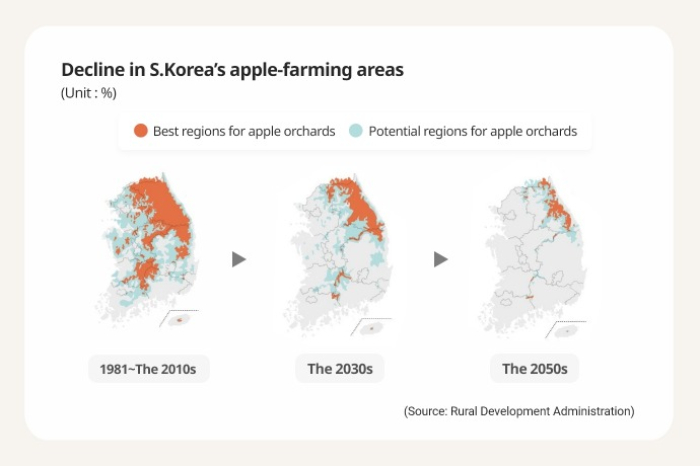
But they have been gradually losing ground as ideal apple farming areas due to climate change.
At the current pace of rising annual temperatures, by 2100 apples are projected to be produced only in some parts of Gangwon Province in the northeastern corner of Korea, above North Gyeongsang Province.
It is already happening.
According to the Rural Development Administration on Wednesday, the apple-farming area in North Gyeongsang Province shrank by 44% from 30 years ago to 20,151 hectares, and that in Daegu also contracted to 86 ha from 447 ha over the same period.
They are still Korea’s major apple-growing regions, but the number of apple orchards in Gangwon Province has more than tripled over the past three decades.
“Something unthinkable a decade ago has become a reality,” said Kwon Min-soo, the chief executive officer of Farmair. “Climate change will change not only apple supply but our country’s entire crop production map.”
STRICT FRUIT IMPORT REGULATIONS
Against the falling local production, some people suggest that Korea imports apples from other countries.
Under the current law, it is, however, nearly impossible to bring in foreign apple varieties.
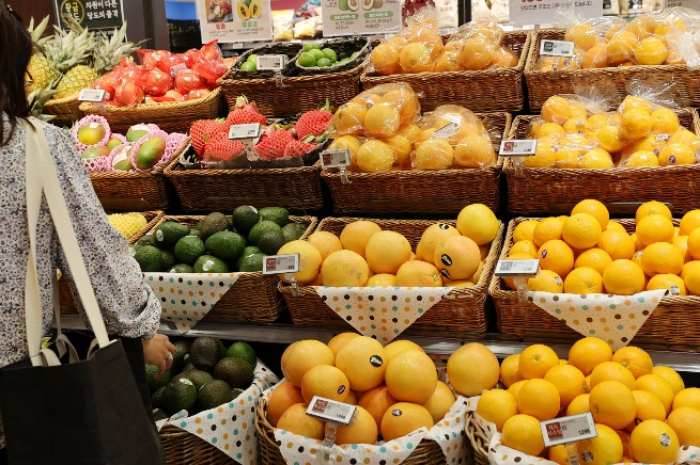
The county currently allows imports of about 30 types of fruit including oranges, grapes and mangos, but has never opened the door to foreign apples.
If other countries want to sell fruit in Korea, their fresh produce must pass the country’s eight-step screening process required by the country’s Plant Protection Act.
The act, designed to protect domestic agricultural and forestry production and conserve the natural environment, is for forest pest control.
Japan and 10 more countries have been going through the screening process for their fresh apples since 1992. Japan, at the fifth stage of screening, could theoretically export fresh apples to Korea sooner than other countries but some of its apples were recently found to carry pests.
As it takes an average of 8.1 years for an overseas fruit to pass the entire screening process to be exported to Korea, some people suggest that the country simplify or skip the pest quarantine process to speed up apple imports.
However, others argue that such a relaxing of rules poses a high risk of pest outbreaks, which could affect other fruit imports.
It could also cause issues to the country’s apple-producing supply chain in the long run.
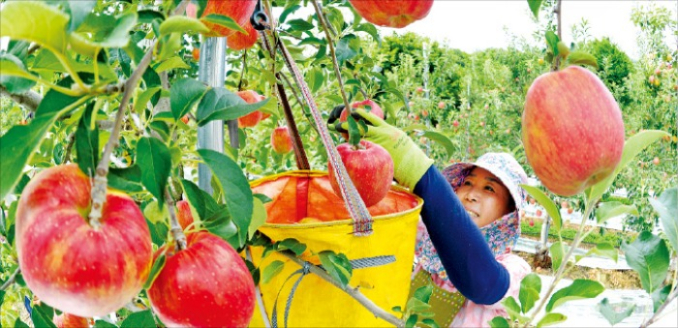
SHORTAGE OF APPLE GROWERS
Korean apple prices are expected to stay high also due to a shortage of apple growers and land driven by the fast-aging population and accelerating rural extinction.
One 74-year-old owner of a local apple orchard said none of her three children want to take over the farm, and her neighbors are also struggling to find new owners of their orchards.
According to the Korea Rural Economic Institute, apple-growing areas in Korea will shrink to 30,900 ha by 2033 from the current 33,800 ha, an 8.6% loss equivalent in area to 4,000 soccer fields.
Due to the decline in apple-farming areas, Korean apple production is forecast to decrease to 485,000 tons in 2033 from this year's 502,000 tons.
Koreans are expected to grapple with "appflation" for a while due to an anticipated shortage of fresh apples after May.
The key to apple production and supply is weather.
If spring frosts and torrential rains in summer are repeated this year, the country’s apple harvest will fall again.
Agricultural experts recommend Korea come up with a long-term plan to stabilize apple supply against climate change and the country's aging population.
Write to Sul-Li Jun and Hyung-Joo Oh at sljun@hankyung.com
Sookyung Seo edited this article.
More to Read
-
 EconomyKorea’s inflation rebounds, BOK to keep interest rates in H1
EconomyKorea’s inflation rebounds, BOK to keep interest rates in H1Mar 06, 2024 (Gmt+09:00)
1 Min read -

Comment 0
LOG IN


